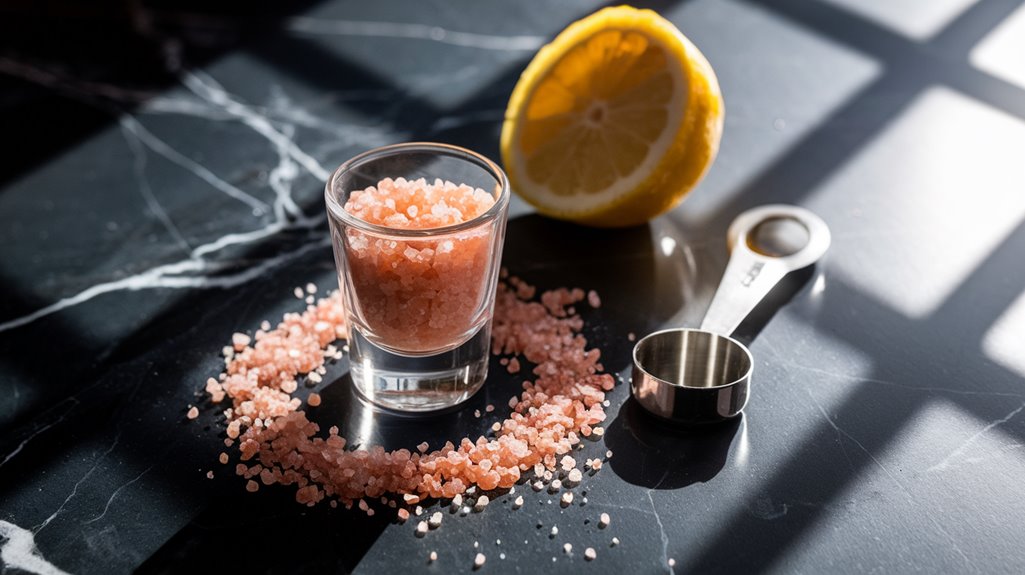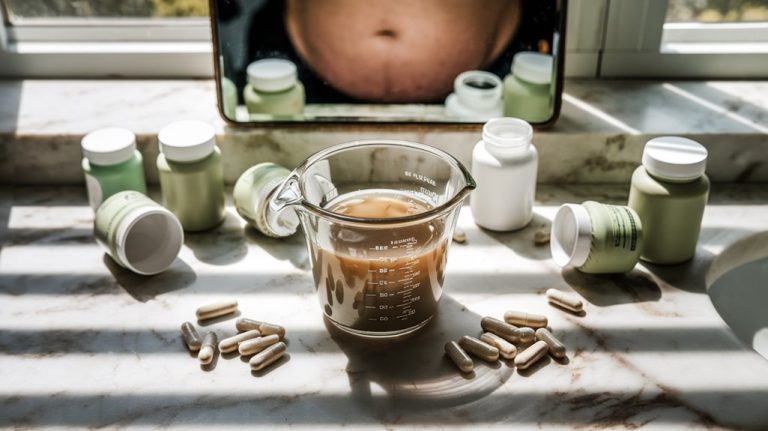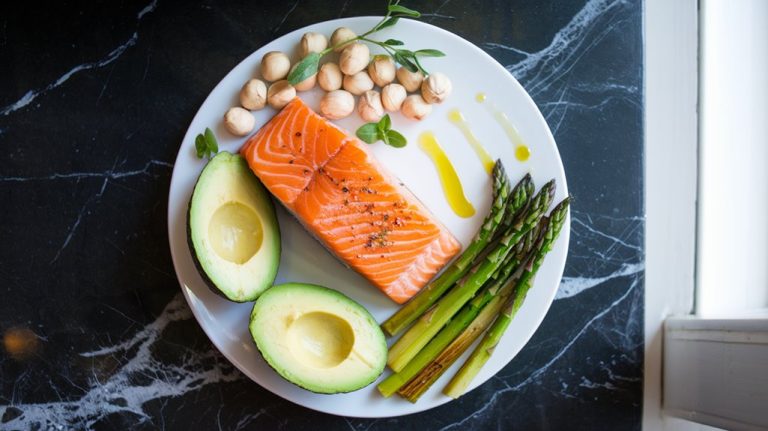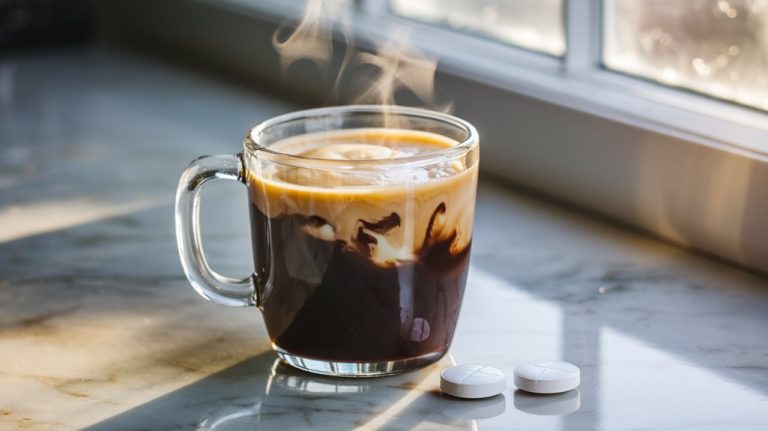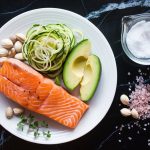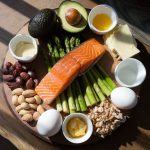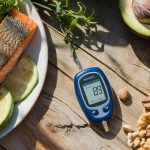On a ketogenic diet, you'll need considerably more sodium than usual – about 3,000-5,000mg daily – due to increased salt loss from lower insulin levels. Strategic salt shots, using 1/4 to 1/2 teaspoon of mineral-rich salt in water, can help prevent keto flu symptoms and maintain ideal electrolyte balance. Timing these shots 30 minutes before breakfast and around workouts maximizes their effectiveness for ketone production and metabolic efficiency. Understanding the proper protocol can transform your ketogenic experience.
Keto Highlights
- Salt shots boost ketone production by providing 3,000-5,000mg daily sodium intake, essential for maintaining ketosis and preventing keto flu symptoms.
- Strategic timing of salt shots before breakfast and workouts enhances metabolic efficiency and supports optimal ketone levels.
- Adding lemon juice or apple cider vinegar to salt shots improves absorption rates and helps maintain consistent electrolyte balance.
- High-quality salts like Himalayan pink or sea salt provide sustained mineral release and better support for ketone production.
- Regular salt shots prevent common ketosis-related issues like fatigue, headaches, and muscle cramps while supporting overall metabolic health.
Understanding Salt's Critical Role in Ketogenic Success
While many focus on macronutrient ratios in ketogenic dieting, sodium management plays an equally essential role in achieving ideal results. When you restrict carbohydrates, your insulin levels drop considerably, triggering your kidneys to excrete more sodium than usual. This increased sodium loss, coupled with water excretion, can quickly lead to electrolyte imbalances.
You'll need to consume 3,000-5,000 mg of sodium daily on a ketogenic diet – considerably more than the standard 2,300 mg recommendation. This increased intake isn't just about preventing keto flu; it's vital for maintaining proper fluid balance, supporting nerve function, and facilitating muscle contractions. Without adequate sodium, you may experience fatigue, headaches, and reduced performance, potentially undermining your ketogenic journey's success.
The Science Behind Salt and Ketone Production
Understanding the relationship between salt intake and ketone production requires examining both endogenous ketogenesis and exogenous supplementation. Your body's ketogenic metabolism relies heavily on proper electrolyte balance, with sodium playing a vital role in maintaining hydration and preventing keto flu symptoms.
| Factor | Impact on Ketosis |
|---|---|
| Sodium Levels | Influences ketone production efficiency |
| Salt Intake | Helps maintain electrolyte balance |
| Ketone Salts | Raise BHB levels to ~1 mM |
| Absorption Rate | Slower than ketone esters |
| Blood Pressure | May decrease with chronic use |
When you're in ketosis, your kidneys excrete more sodium, necessitating increased intake. While ketone salt supplements can provide both BHB and minerals, they're less effective than esters at elevating blood ketone levels. However, adequate sodium consumption remains essential for optimizing your body's natural ketone production and maintaining metabolic efficiency.
Why Traditional Salt Intake Guidelines Don't Apply to Keto
Because traditional salt intake guidelines were developed for high-carb diets, they don't account for the unique metabolic changes that occur during ketosis. When you're following a ketogenic diet, your body's sodium requirements increase markedly due to increased excretion through the kidneys.
The standard recommendation of 2300mg sodium daily becomes insufficient as your insulin levels drop, signaling your kidneys to release more salt. You'll likely need 4000-7000mg of sodium daily – roughly 2-3 teaspoons of salt – to maintain proper electrolyte balance. This increased need stems from the metabolic shift that occurs when your body depletes glycogen stores, resulting in water and electrolyte loss. Without adequate sodium intake, you may experience symptoms of electrolyte imbalance, commonly known as "keto flu."
Mastering the Art of Salt Shots for Optimal Ketosis
Taking salt shots represents a strategic approach to maintaining electrolyte balance during ketosis. You'll want to start with 1/4 to 1/2 teaspoon of mineral-rich salt dissolved in water, taken 1-3 times daily depending on your needs.
Timing is essential for maximum benefits. Take your first shot 30 minutes before breakfast, followed by pre- and post-workout doses if you're exercising. Choose unrefined options like Himalayan pink salt, Celtic sea salt, or Redmond Real Salt for their abundant trace minerals – elements significantly absent in regular table salt.
You can enhance your salt shots by adding lemon juice or apple cider vinegar to improve absorption and taste. Consider incorporating electrolyte powders for additional mineral support, and use warm water to guarantee proper dissolution.
Common Signs You Need More Salt on Keto
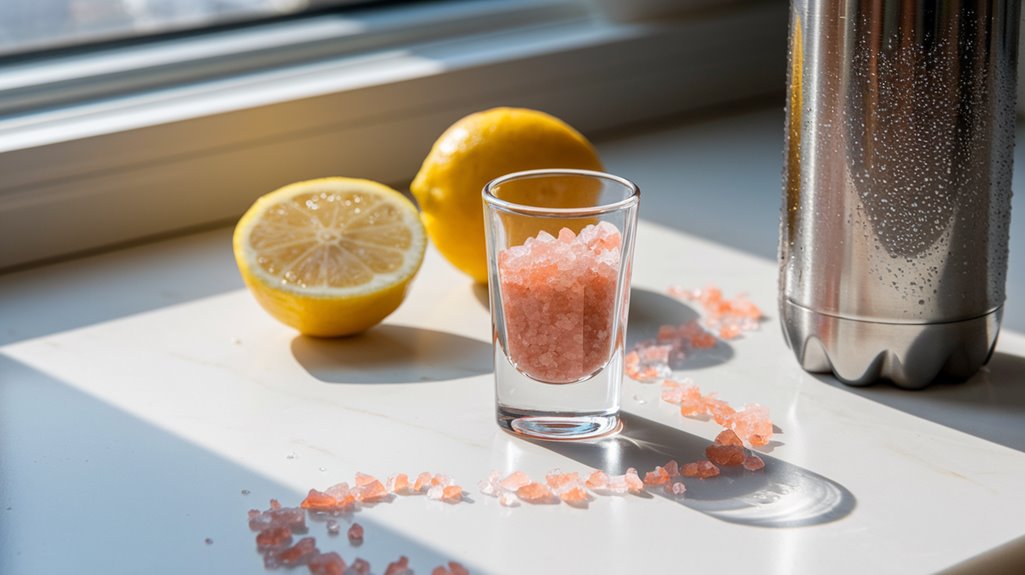
While mastering salt shots helps maintain electrolyte balance, recognizing when your body needs additional sodium allows for timely intervention. You'll notice physical symptoms first: muscle cramps, weakness, and fatigue often signal electrolyte depletion. Watch for cognitive changes like brain fog, difficulty concentrating, or unexplained irritability.
Your digestive system may also indicate sodium deficiency through bloating, constipation, or sudden changes in appetite. Pay attention to unusual salt cravings and increased thirst. Physical manifestations can include low blood pressure, especially when standing up quickly, along with excessive sweating or changes in sweat patterns.
Monitor your urine color – dark urine suggests dehydration, which often accompanies electrolyte imbalance. If you experience irregular heartbeat, dizziness, or persistent headaches, these could indicate significant sodium depletion requiring immediate attention.
Timing Your Salt Intake for Maximum Benefits
When you're following a ketogenic diet, strategic salt timing can greatly enhance your workout performance and prevent overnight electrolyte depletion. You'll want to consume salt 30-60 minutes before exercise to maintain proper sodium levels and prevent cramping during your training session. Taking a measured dose of salt before bed helps maintain electrolyte balance while you sleep, reducing the risk of morning headaches and fatigue.
Pre-Workout Salt Strategy
To maximize the benefits of salt supplementation before exercise, proper timing plays a crucial role in enhancing performance and preventing discomfort. You'll want to consume your salt dose 30-60 minutes before your workout, allowing sufficient time for absorption and fluid balance adjustment.
Start with 1/4 to 1/2 teaspoon of Himalayan pink salt, mixed with water or your pre-workout supplement. This provides approximately 300-600mg of sodium, supporting blood volume, muscle contractions, and hydration status. You can adjust this amount based on your individual sweat rate and exercise intensity.
Be mindful of your body's response. If you have hypertension, consult your healthcare provider before implementing this strategy. Remember to pair your salt intake with adequate fluids for best results and to prevent potential gastrointestinal issues.
Overnight Depletion Prevention
Beyond daytime salt supplementation, managing your evening salt intake can greatly impact your ketogenic success. Since ketosis increases sodium excretion throughout the day, you'll need to prevent overnight electrolyte depletion during your extended fasting period.
Take 1/4 to 1/2 teaspoon of salt 1-2 hours before bedtime, providing 500-1000mg of sodium. You can dissolve it in warm water, add it to herbal tea, or incorporate it into your final keto-friendly meal. Avoid consuming salt immediately before sleep to prevent disruptions to your rest.
Monitor your morning symptoms to adjust your dosage. If you're experiencing headaches or fatigue upon waking, you may need to increase your evening intake, especially following days of intense physical activity. This strategic timing guarantees ideal hydration and electrolyte balance throughout your sleep cycle.
Different Salt Types and Their Impact on Ketosis
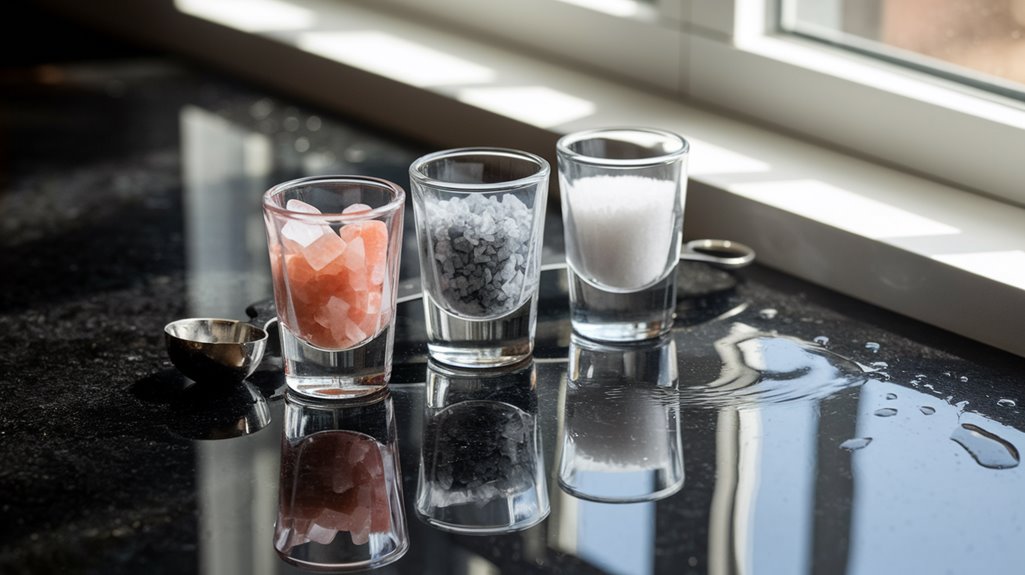
While Himalayan pink salt contains 84 trace minerals compared to table salt's limited mineral profile, both can effectively support your ketogenic journey when properly supplemented. Mineral-rich salts like Himalayan and Celtic sea salt provide additional electrolytes that enhance cellular absorption and help maintain proper fluid balance during ketosis. You'll find that unrefined salts are absorbed more gradually by your body, providing sustained electrolyte support throughout the day rather than the rapid spike and drop associated with regular table salt.
Himalayan Vs Table Salt
Since following a ketogenic diet increases sodium excretion, your choice of salt becomes vital for maintaining proper electrolyte balance. Both Himalayan and table salt can meet your increased sodium needs of 4000-5000mg daily, but they differ considerably in processing and composition.
Key differences you should consider:
- Processing: Table salt undergoes heavy refinement and contains additives, while Himalayan salt is minimally processed and additive-free
- Iodine content: Table salt is typically iodized, providing essential thyroid support, whereas Himalayan salt contains only trace amounts of natural iodine
- Culinary properties: Himalayan salt offers a complex mineral-rich flavor profile ideal for finishing dishes, while table salt's quick-dissolving properties make it better suited for baking
If you're exclusively using Himalayan salt, you'll need to make sure adequate iodine intake from other sources to support thyroid function and metabolism.
Mineral Content Comparison
The mineral composition of different salt varieties directly impacts your success on a ketogenic diet. While table salt contains 39% sodium with minimal trace minerals, sea salt offers 38% sodium alongside higher concentrations of essential minerals like magnesium, calcium, and potassium.
You'll find Himalayan salt contains 37% sodium and an impressive array of 84 trace minerals, making it a thorough option for maintaining electrolyte balance during ketosis. Celtic salt stands out with its 33% sodium content and the highest magnesium levels among common salt varieties, which can help prevent muscle cramps and fatigue. Redmond Real Salt, though primarily sodium chloride at 98%, still provides beneficial trace minerals that support thyroid function and metabolic processes during ketogenic adaptation.
Salt's Absorption Rate Benefits
Understanding how different salt types absorb into your bloodstream can considerably impact your ketogenic success. For ideal ketosis support, it is crucial to take into account both absorption rates and mineral content when selecting your salt type. While table salt offers rapid absorption, unrefined options like sea salt and Himalayan pink salt provide sustained mineral release that better supports ketone production.
Key absorption benefits for ketosis include:
- Pickling salt and kosher salt dissolve quickly, providing immediate electrolyte support during keto adaptation
- Sea salt's slower absorption rate helps maintain stable sodium levels throughout your day
- Himalayan pink salt's measured release supports consistent ketone production while delivering trace minerals
When combined with strategic timing, these absorption differences enable you to customize your salt intake for maximum metabolic benefit during ketosis.
Salt Shots vs. Traditional Electrolyte Supplements
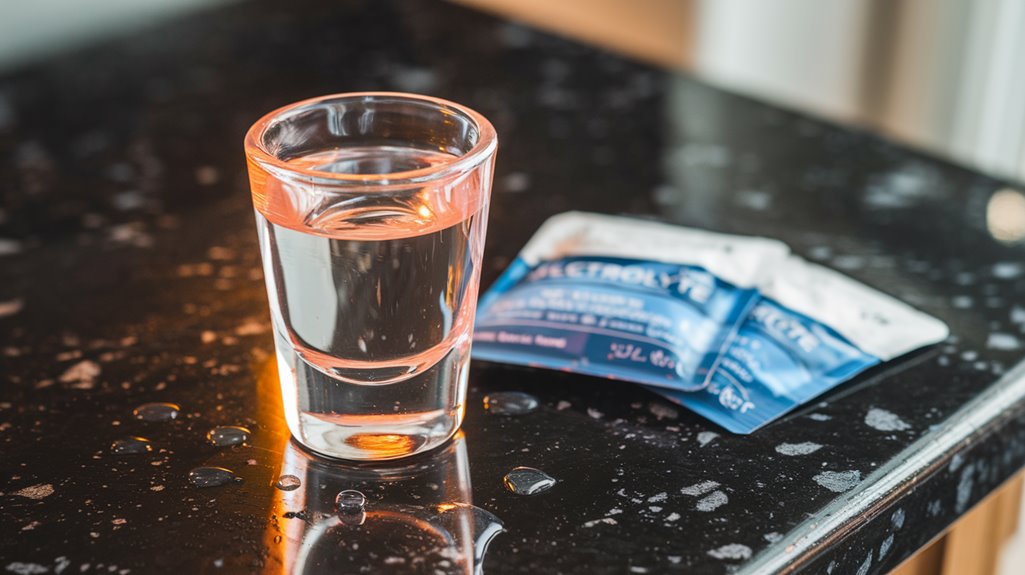
When choosing between salt shots and traditional electrolyte supplements, you'll find distinct differences in their composition and effectiveness. While salt shots deliver concentrated sodium chloride for rapid absorption, traditional electrolyte supplements offer a more balanced mineral profile including potassium and magnesium.
Research shows that 75% of athletes report enhanced performance with electrolyte powders compared to salt alternatives. You'll get additional benefits from electrolyte supplements' inclusion of carbohydrates and other nutrients, while salt shots provide only sodium chloride. However, salt shots' portability makes them convenient for quick sodium replenishment.
Consider your specific needs carefully. If you're seeking thorough mineral replenishment, electrolyte supplements might be your better choice. For rapid sodium intake, salt shots can work effectively, but you'll need to properly dilute them to avoid gastrointestinal discomfort.
Combining Salt Shots With Exogenous Ketones
When combining salt shots with exogenous ketones, you'll want to take your salt shot 15-30 minutes before your ketone supplement to optimize absorption and metabolic synergy. You should maintain a 2:1 ratio of sodium (in milligrams) to ketone ester (in grams) while starting with lower doses to assess your tolerance and prevent gastrointestinal discomfort. To guarantee safety and maximum benefits, it's essential to space out your doses throughout the day, stay well-hydrated, and monitor your body's response, particularly during exercise or periods of increased ketone demand.
Timing For Maximum Benefits
To maximize the benefits of combining salt shots with exogenous ketones, precise timing is essential for prime absorption and metabolic effects. Take your salt shot 15-30 minutes before consuming exogenous ketones on an empty stomach, then wait 30-60 minutes before eating any food.
For best results throughout your day, follow these key timing guidelines:
- Morning: Take salt upon waking, followed by ketones 15-30 minutes later
- Pre-workout: Consume salt 30 minutes before exercise, with ketones immediately before starting
- Post-workout: Use salt within 30 minutes, followed by ketones for enhanced recovery
Monitor your blood ketone levels 30-60 minutes after combined intake to assess effectiveness. Limit yourself to 2-3 combined doses daily to avoid excessive mineral consumption and maintain proper electrolyte balance.
Salt-Ketone Ratio Guidelines
Understanding proper salt-to-ketone ratios is essential for maximizing the benefits of combined supplementation. The ideal ratio typically ranges from 1:1 to 1:3 (salt:BHB), with specific ratios tailored to your needs. Athletes may benefit from higher ratios around 2:1, while general ketosis support often requires lower ratios of 1:2 or 1:3.
You'll need to monitor your intake carefully, as ketone salts contain 0.3-0.5g BHB per 1g of salt. While following a ketogenic diet may increase your sodium requirements to 3,000-5,000mg daily, you shouldn't exceed 2,300mg without medical supervision. Track your blood pressure and ketone levels regularly, aiming for 0.5-3.0 mmol/L BHB for nutritional ketosis. Consider complementary electrolytes like potassium and magnesium to maintain ideal balance.
Absorption And Safety Tips
Combining salt shots with exogenous ketones requires careful consideration of absorption timing and safety protocols. While ketone supplementation can effectively induce ketosis, the addition of salt shots may increase your risk of excessive sodium intake, particularly when using ketone salts that already contain high electrolyte loads.
For ideal safety and effectiveness, follow these key guidelines:
- Allow a 30-minute absorption window after ketone supplementation before any intense activity
- Monitor your total sodium intake when using ketone salts, as additional salt shots may be unnecessary
- Consider using ketone esters instead of salts if you're sensitive to sodium or have cardiovascular concerns
Remember that ketone effects are transient, typically peaking within hours of consumption. If you're using sodium bicarbonate to address ketone-induced acidity, carefully time your intake to minimize potential gastrointestinal distress.
Athletic Performance and Salt Requirements on Keto
While following a ketogenic diet, athletes face unique challenges regarding sodium balance due to increased excretion rates. You'll need 2-4 grams of sodium daily, which is 1-2 grams more than non-keto athletes require. This increased requirement stems from lower insulin levels that affect sodium retention.
| Performance Factor | Impact of Low Sodium | Solution |
|---|---|---|
| Endurance | Decreased stamina | Add 1/4 tsp salt to pre-workout |
| Muscle Function | Cramping & weakness | Consume bone broth daily |
| Hydration | Poor fluid balance | Salt-enhanced beverages |
| Recovery | Delayed recuperation | Post-workout electrolytes |
Track your intake through food logging and monitor hydration status via urine color. Consider supplementing with Himalayan pink salt or sea salt in beverages, and incorporate sodium-rich foods like celery and salted nuts into your nutrition plan.
Preventing Keto Flu Through Strategic Salt Loading
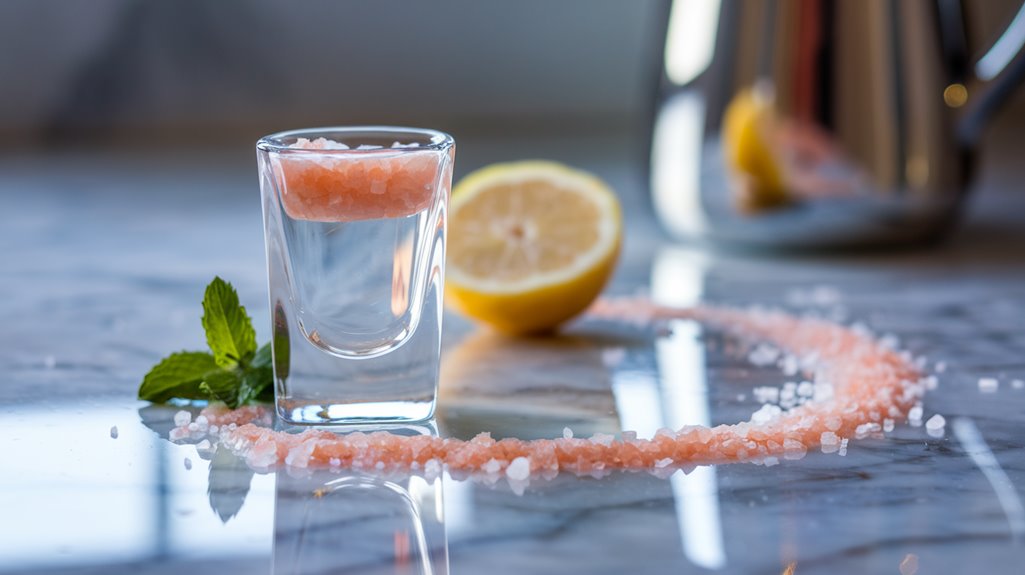
You'll need to time your salt intake strategically throughout the day to prevent keto flu symptoms, focusing on periods when electrolyte demands are highest like morning and post-exercise. Strategic salt loading involves consuming 3,000-5,000 mg of sodium daily through a combination of bone broth, salted water, and mineral-rich foods to maintain proper fluid balance. By pairing sodium intake with potassium and magnesium-rich foods, you're creating an ideal electrolyte environment that supports your body's adaptation to ketosis while minimizing common side effects.
Salt Timing Matters Most
Although many focus solely on salt quantity during ketosis, the timing of salt consumption plays a crucial role in preventing keto flu symptoms. Strategic timing of your salt intake can enhance your metabolic shift and maintain steady energy levels throughout the day.
Your daily salt timing strategy should prioritize these key intervals:
- Morning salt shot to prevent symptoms and support early metabolism
- Pre-workout dosing to enhance exercise performance
- Meal-time consumption to maximize nutrient absorption
Evening salt intake should be minimized to prevent sleep disruption. For best absorption, split your daily 1-2 teaspoons into 3-4 smaller doses. This approach maintains consistent electrolyte balance while supporting your body's natural rhythms. When combined with proper hydration, well-timed salt consumption becomes a powerful tool for managing ketosis effectively.
Electrolyte Balance Through Loading
Strategic salt loading represents a key method for preventing keto flu symptoms and maintaining ideal electrolyte balance during ketosis. You'll need to consume 2-4 grams of sodium daily, ideally through high-quality sources like Himalayan pink salt or sea salt.
To implement this approach effectively, you can add salt to your water, take measured salt shots before meals, or incorporate bone broth into your routine. This systematic loading helps support insulin sensitivity, proper hydration, and athletic performance during your keto shift.
For best results, pair your salt loading with other electrolyte strategies. Include potassium-rich foods like avocados and spinach, supplement with magnesium, and consider sugar-free electrolyte powders. This all-encompassing approach guarantees smoother adaptation to fat-burning metabolism while preventing common adjustment symptoms.
Safety Guidelines for Salt Consumption While Ketogenic
While following a ketogenic diet requires considerably higher sodium intake than standard dietary recommendations, maintaining safe consumption levels is crucial for ideal health and performance. Your daily target should range between 3,000-5,000mg of sodium, notably higher than the standard 2,300mg RDA.
To guarantee safe salt consumption while maintaining ketosis:
- Track your sodium intake meticulously for 4-6 weeks through food logging
- Monitor for signs of imbalance including fatigue, headaches, or muscle cramps
- Balance sodium with 3,000-4,000mg of potassium daily
Focus on incorporating natural sodium sources like bone broths, pickled vegetables, and unprocessed meats rather than relying solely on supplements. If you're experiencing symptoms or taking medications, consult your healthcare provider to determine ideal intake levels for your specific situation.
Building Your Personal Salt Shot Protocol
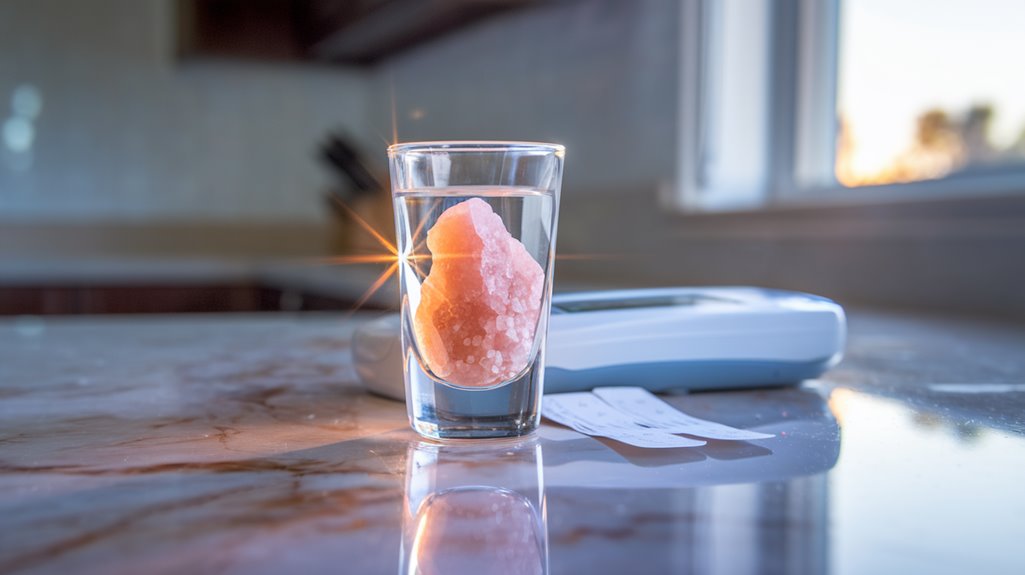
Building an effective salt shot protocol requires a methodical, personalized approach based on your unique physiological needs and daily routines. Start by getting your baseline sodium levels tested and consulting your healthcare provider for individualized recommendations.
Begin with a morning salt shot of 1/4 teaspoon mixed in warm water, then strategically time additional shots before exercise and throughout your day. You'll want to use high-quality sea salt or pink Himalayan salt for ideal mineral content, ensuring fine-grain texture for better dissolution. Monitor your body's response by tracking urine color and frequency.
Gradually adjust your protocol based on factors like activity level, climate, and sweating patterns. You can increase dosage as needed while maintaining consistent water intake for proper hydration balance.
Measuring and Tracking Salt Intake Effectively
Accurately tracking your salt intake requires both reliable measurement methods and consistent monitoring tools. While 24-hour urine collection remains the gold standard, you'll likely find practical value in combining multiple tracking approaches for daily monitoring.
Precise salt tracking demands reliable tools and consistent methods, combining daily monitoring strategies for the most accurate picture of sodium consumption.
Track your sodium consumption effectively with these evidence-based methods:
- Measure discretionary salt with precise tools like measuring spoons or a food scale, converting grams to sodium content
- Log all food intake using smartphone apps that feature sodium tracking capabilities
- Document restaurant meals by researching nutrition information beforehand and recording actual consumption
For peak accuracy, maintain detailed food records for at least one week to establish your baseline intake. Be particularly vigilant about hidden sodium in processed foods and remember that self-reported measurements tend to underestimate actual consumption.
Adapting Salt Intake Based on Activity Levels
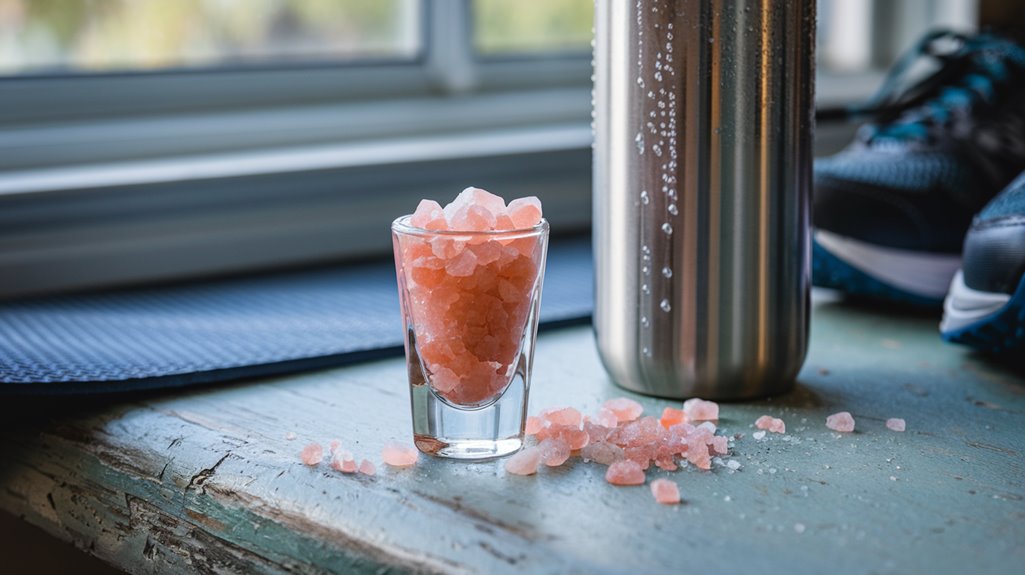
As physical activity levels vary considerably among individuals, your daily sodium requirements must be calibrated accordingly to maintain ideal electrolyte balance. If you're sedentary, aim for 1,500-2,300mg of sodium daily, while monitoring your blood pressure and electrolyte status.
For moderate activity lasting 30-60 minutes, you'll need 2,300-3,000mg to replace sweat losses, adjusting based on climate conditions. High-intensity athletes and endurance performers require markedly more – typically 3,000-5,000mg daily, with an additional gram per hour during intense training sessions.
If you're following a ketogenic diet, you'll need even higher amounts, around 5 grams daily, due to increased sodium excretion. Consider supplementing with bone broth and tracking your symptoms to optimize your intake based on your unique needs and activity level.
Frequently Asked Questions
Can Salt Shots Affect Medication Absorption or Timing?
Yes, your salt shots can greatly affect medication absorption and timing. You'll need to space them at least 2 hours from medications, as they alter stomach pH and gastric motility.
How Do Hormonal Changes Impact Salt Requirements During Keto?
Like a domino effect, your hormones – insulin, aldosterone, cortisol, and thyroid – work together to increase salt loss. You'll need 3-5 times more sodium during keto to maintain proper balance.
Does Alcohol Consumption Change Salt Requirements on a Ketogenic Diet?
When you consume alcohol on keto, you'll need increased salt intake due to enhanced sodium excretion. Alcohol's diuretic effects combined with keto's natural sodium-depleting properties can intensify electrolyte imbalances.
Can Salt Shots Help With Intermittent Fasting Headaches While on Keto?
You'll find salt shots effective for fasting headaches during keto, as they quickly restore electrolyte balance, maintain fluid levels, and support nerve function when insulin levels drop naturally.
Do Artificial Sweeteners Affect Salt Balance During Ketosis?
Most artificial sweeteners don't affect your salt balance during ketosis. While sucralose may cause minor insulin responses, sweeteners like stevia, monk fruit, and aspartame won't disrupt your body's sodium regulation.
Conclusion
You'll find that strategic salt intake can dramatically improve your ketogenic journey, with studies showing up to 65% of new keto dieters experiencing electrolyte imbalances in the first month. By mastering your personal salt protocol and adjusting intake based on activity levels, you're well-positioned to optimize ketone production and minimize adaptation symptoms. Remember to track your intake and monitor your body's signals for best results.
References
- https://ketone.com/blogs/blog/exogenous-ketones-ketone-salts-ketosis-with-a-cost
- https://www.youtube.com/watch?v=WNV0GJcrqp4
- https://wellversed.in/blogs/articles/why-is-salt-needed-in-the-keto-diet
- https://www.mynewroots.org/2013/02/the-life-changing-loaf-of-bread/
- https://aletenutrition.com/blogs/saltstick-blog/ketogenic-extra-salt
- https://statmodeling.stat.columbia.edu/2024/07/17/bill-james-hangs-up-his-hat/
- https://www.healthline.com/nutrition/pruvit-keto-os
- https://www.docmuscles.com/salt-keto/
- https://www.healthline.com/nutrition/exogenous-ketones
- https://www.medicalnewstoday.com/articles/326607
- https://www.thelowcarbgrocery.com/low-carb-lifestyle-blog/low-carb-basics/salt-and-keto-dieting
- https://www.drberg.com/blog/tired-from-not-enough-salt-heres-why
- https://ketogenic.com/why-do-we-need-more-salt-on-keto/
- https://countrywalksinketosis.com/2014/11/09/the-role-of-salt-in-a-ketogenic-diet-keto-flu-explained/
- https://www.drberg.com/blog/ketosis-and-sodium
- https://www.virtahealth.com/blog/potassium-sodium-ketogenic-diet
- https://www.ncbi.nlm.nih.gov/books/NBK499830/
- https://onlinelibrary.wiley.com/doi/10.1155/2018/9812806
- https://journals.physiology.org/doi/full/10.1152/ajpcell.00485.2023
- https://journalofmetabolichealth.org/index.php/jmh/article/view/47/172

